- Home
- Bill Bryson
The Life And Times Of The Thunderbolt Kid: A Memoir (v5.0) Page 13
The Life And Times Of The Thunderbolt Kid: A Memoir (v5.0) Read online
Page 13
At the peak of the Red Scare, thirty-two of the forty-eight states had loyalty oaths of one kind or another. In New York, Oakley notes, it was necessary to swear a loyalty oath to gain a fishing permit. In Indiana loyalty oaths were administered to professional wrestlers. The Communist Control Act of 1954 made it a federal offense to communicate any Communist thoughts by any means, including by semaphore. In Connecticut it became illegal to criticize the government, or to speak ill of the army or the American flag. In Texas you could be sent to prison for twenty years for being a Communist. In Birmingham, Alabama, it was illegal merely to be seen conversing with a Communist.
HUAC issued millions of leaflets entitled “One Hundred Things You Should Know About Communism,” detailing what to look out for in the behavior of neighbors, friends, and family. Billy Graham, the esteemed evangelist, declared that more than one thousand decent-sounding American organizations were in fact fronts for Communist enterprises. Rudolf Flesch, author of the best-selling Why Johnny Can’t Read, insisted that a failure to teach phonics in schools was undermining democracy and paving the way for Communism. Westbrook Pegler, a syndicated columnist, suggested that anyone found to have been a Communist at any time in his life should simply be put to death. Such was the sensitivity, according to David Halberstam, that when General Motors hired a Russian automotive designer named Zora Arkus-Duntov, it described him in press releases, wholly fictitiously, as being “of Belgian extraction.”
No one exploited the fear to better effect than Joseph R. McCarthy, Republican senator from Wisconsin. In 1950, in a speech in Wheeling, West Virginia, he claimed to have in his pocket a list of 205 Communists working in the State Department. The next day he claimed to have another list with fifty-seven names on it. Over the next four years McCarthy waved many lists, each claiming to show a different number of Communist operatives. In the course of his spirited ramblings he helped to ruin many lives without ever producing a single promised list. Not producing evidence was becoming something of a trend.
Others brought additional prejudices into play. John Rankin, a senior congressman from Mississippi, sagely observed: “Remember, Communism is Yiddish. I understand that every member of the Politburo around Stalin is either Yiddish or married to one, and that includes Stalin himself.” Against such men, McCarthy looked almost moderate and fairly sane.
Such was the hysteria that it wasn’t actually necessary to have done anything wrong to get in trouble. In 1950, three former FBI agents published a book called Red Channels: The Report of Communist Influence in Radio and Television, accusing 151 celebrities—among them Leonard Bernstein, Lee J. Cobb, Burgess Meredith, Orson Welles, Edward G. Robinson, and the stripper Gypsy Rose Lee—of various seditious acts. Among the shocking misdeeds of which the performers stood accused were speaking out against religious intolerance, opposing fascism, and supporting world peace and the United Nations. None had any connection with the Communist Party or had ever shown any Communist sympathies. Even so, many of them couldn’t find work for years afterward unless (like Edward G. Robinson) they agreed to appear before HUAC as a friendly witness and name names.
Doing anything at all to help Communists became essentially illegal. In 1951, Dr. Ernest Chain, a naturalized Briton who had been awarded a Nobel Prize six years earlier for helping to develop penicillin, was barred from entering the United States because he had recently traveled to Czechoslovakia, under the auspices of the World Health Organization, to help start a penicillin plant there. Humanitarian aid was only permissible, it seems, so long as those being saved believed in free markets. Americans likewise found themselves barred from travel. Linus Pauling, who would eventually receive two Nobel Prizes, was stopped at Idlewild Airport in New York while boarding a plane to Britain, where he was to be honored by the Royal Society, and had his passport confiscated on the grounds that he had once or twice publicly expressed a liberal thought.
It was even harder for those who were not American by birth. After learning that a Finnish-born citizen named William Heikkilin had in his youth briefly belonged to the Communist Party, Immigration Service employees tracked him down in San Francisco, arrested him on his way home from work, and bundled him onto an airplane bound for Europe, with nothing but about a dollar in change and the clothes he was wearing. Not until his plane touched down the following day did officials inform his frantic wife that her husband had been deported. They refused to tell her where he had been sent.
In perhaps the most surreal moment of all, Arthur Miller, the playwright, while facing congressional rebuke and the possibility of prison for refusing to betray friends and theatrical associates, was told that the charges against him would be dropped if he would allow the chairman of HUAC, Francis E. Walter, to be photographed with Miller’s famous and dishy wife, Marilyn Monroe. Miller declined.
In 1954, McCarthy finally undid himself. He accused General George Marshall, the man behind the Marshall Plan and a person of unquestioned rectitude, of treason, a charge quickly shown to be preposterous. Then he took on the whole of the United States Army, threatening to expose scores of subversive senior staff that he claimed the army knowingly shielded within its ranks. In a series of televised hearings lasting thirty-six days in the spring of 1954 and known as the Army-McCarthy hearings, he showed himself to be a bullying, blustering buffoon of the first rank without a shred of evidence against anyone—though in fact he had always shown that. It just took this long for most of the nation to realize it.
Later that year McCarthy was severely censured by the Senate—a signal humiliation. He died three years later in disgrace. But the fact is that had he been just a tiny bit smarter or more likable, he might well have become president. In any case, McCarthy’s downfall didn’t slow the assault on Communism. As late as 1959, the New York office of the FBI still had four hundred agents working full time on rooting out Communists in American life, according to Kenneth O’Reilly in Hoover and the Un-Americans.
Thanks to our overweening preoccupation with Communism at home and abroad America became the first nation in modern history to build a war economy in peacetime. Defense spending in the fifties ranged between $40 billion and $53 billion a year—or more than total government spending on everything at the dawn of the decade. Altogether the United States would lay out $350 billion on defense during the eight years of the Eisenhower presidency. More than this, 90 percent of our foreign aid was for military expenditures. We didn’t just want to arm ourselves; we wanted to make sure that everybody else was armed, too.
Often, all that was necessary to earn America’s enmity, and land yourself in a lot of trouble, was to get in the way of our economic interests. In 1950, Guatemala elected a reformist government—“the most democratic Guatemala ever had,” according to the historian Howard Zinn—under Jacobo Arbenz, an educated landowner of good intentions. Arbenz’s election was a blow for the American company United Fruit, which had run Guatemala as a private fiefdom since the nineteenth century. The company owned nearly everything of importance in the country—the ports, the railroads, the communications networks, banks, stores, and some 550,000 acres of farmland—paid little taxes, and could count confidently on the support of a string of repressive dictators.
Some 85 percent of United Fruit’s land was left more or less permanently idle. This kept fruit prices high, but Guatemalans poor. Arbenz, who was the son of Swiss immigrants and something of an idealist, thought this was unfair and decided to remake the country along more democratic lines. He established free elections, ended racial discrimination, encouraged a free press, introduced a forty-hour work week, legalized unions, and ended government corruption.
Needless to say, most people loved him. In an attempt to reduce poverty, he devised a plan to nationalize, at a fair price, much of the idle farmland—including 1,700 acres of his own—and redistribute it in the form of small farms to a hundred thousand landless peasants. To that end Arbenz’s government expropriated 400,000 acres of land from United Fruit, and offered as comp
ensation the sum that the company had claimed the land was worth for tax purposes—$1,185,000.
United Fruit now decided the land was worth $16 million actually—a sum the Guatemalan government couldn’t afford to pay. When Arbenz turned down United Fruit’s demand for the higher level of compensation, the company complained to the United States government, which responded by underwriting a coup.
Arbenz fled his homeland in 1954 and a new, more compliant leader named Carlos Castillo Armas was installed. To help him on his way, the CIA gave him a list of seventy thousand “questionable individuals”—teachers, doctors, government employees, union organizers, priests—who had supported the reforms in the belief that democracy in Guatemala was a good thing. Thousands of them were never seen again.
And on that sobering note, let us return to Kid World, where the denizens may be small and often immensely stupid, but are at least comparatively civilized.
Chapter 8
SCHOOL DAYS
In Pasadena, California, student Edward Mulrooney was arrested after he tossed a bomb at his psychology teacher’s house and left a note that said: “If you don’t want your home bombed or your windows shot out, then grade fairly and put your assignments on the board—or is this asking too much?”
Time magazine, April 16, 1956
GREENWOOD, MY ELEMENTARY SCHOOL, was a wonderful old building, enormous to a small child, like a castle made of brick. Built in 1901, it stood off Grand Avenue at the far end of a street of outstandingly vast and elegant homes. The whole neighborhood smelled lushly of old money.
Stepping into Greenwood for the first time was both the scariest and most exciting event of the first five years of my life. The front doors appeared to be about twenty times taller than normal doors, and everything inside was built to a similar imposing scale, including the teachers. Everything about it was intimidating and thrilling at once.
It was, I believe, the handsomest elementary school I have ever seen. Nearly everything in it—the cool ceramic water fountains, the polished corridors, the cloakrooms with their neatly spaced ancient coat hooks, the giant clanking radiators with their intricate embossed patterns like iron veins, the glass-fronted cupboards, everything—had an agreeable creak of solid, classy, utilitarian venerability. This was a building made by craftsmen at a time when quality counted, and generations of devoted childhood learning suffused the air. If I hadn’t had to spend so much of my time vaporizing teachers I would have adored the place.
Still, I was very fond of the building. One of the glories of life in that ancient lost world of the mid-twentieth century was that facilities designed for kids often were just smaller versions of things in the adult world. You can’t imagine how much more splendid this made them. Our Little League baseball field, for instance, was a proper ballpark, with a grandstand, concession stand and press box, and real dugouts that were, as the name demands, partly subterranean (and never mind that they filled with puddles after every rain and that the shorter players couldn’t see over the edge and so tended to cheer at the wrong moments). When you ran up those three sagging steps and out onto the field you could seriously imagine that you were in Yankee Stadium. Superior infrastructure makes for richer fantasies, believe me. Greenwood contained all that in spades.
It had, for one thing, an auditorium that was just like a real theater, with a stage with curtains and spotlights and dressing rooms behind. So however bad your school productions were—and ours were always extremely bad, partly because we had no talent and partly because Mrs. De Voto, the music teacher, was a bit ancient and often nodded off at the piano—it felt like you were part of a well-ordered professional undertaking (even when you were standing there holding a long note waiting for Mrs. De Voto’s chin to touch the keyboard, an event that always jerked her back into action with rousing gusto at exactly the spot where she had left off a minute or two before).
Greenwood also had the world’s finest gymnasium. It was upstairs at the back of the school, which gave it a nicely unexpected air. When you opened the door, you expected to find an ordinary classroom and instead you had—hey! whoa!—a gigantic cubic vault of polished wood. It was a space to savor: it had cathedral-sized windows, a ceiling that no ball could ever reach, acres of varnished wood that had been mellowed into a honeyed glow by decades of squeaky sneakers and gentle drops of childish perspiration, and smartly echoing acoustics that made every bouncing ball sound deftly handled and seriously athletic. When the weather was good and we were sent outdoors to play, the route to the playground took us onto a rickety metal fire escape that was unnervingly but grandly lofty. The view from the summit took in miles of rooftops and sunny countryside reaching practically to Missouri, or so it seemed.
Mostly we played indoors, however, because it was nearly always winter outside. Of course winters in those days, as with all winters of childhood, were much longer, snowier, and more frigid than now. We used to get up to eleven feet of snow at a time—we seldom got less, in fact—and weeks of arctic weather so bitter you could pee icicles.
In consequence, they used to keep the school heated to roughly the temperature of the inside of a pottery kiln, so pupils and teachers alike existed in a state of permanent, helpless drowsiness. But at the same time the close warmth made everything deliciously cheery and cozy. Even Lumpy Kowalski’s daily plop in his pants smelled oven-baked and kind of strangely lovely. (For six months of the year, his pants actually steamed.) On the other hand, the radiators were so hot that if you carelessly leaned an elbow on them you could leave flesh behind. The most infamous radiator-based activity was of course to pee on a radiator in one of the boys’ bathrooms. This created an enormous sour stink that permeated whole wings of the school for days on end and could not be got rid of through any amount of scrubbing or airing. For this reason, anyone caught peeing on a radiator was summarily executed.
The school day was largely taken up with putting on or taking off clothing. It was an exhaustingly tedious process. It took most of the morning to take off your outdoor wear and most of the afternoon to get it back on, assuming you could find any of it among the jumbled, shifting heap of garments that carpeted the cloakroom floor to a depth of about three feet. Changing time was always like a scene at a refugee camp, with at least three kids wandering around weeping copiously because they had only one boot or no mittens. Teachers were never to be seen at such moments.
Boots in those days had strange, uncooperative clasps that managed to pinch and lacerate at the same time, producing some really interesting injuries, especially when your hands were numb with cold. The manufacturers really might just as well have fashioned the clasps out of razor blades. Because they were so lethal, you ended up leaving the clasps undone, which was more macho but also let in large volumes of snow, so that you spent much of the day in sopping wet socks, which then became three times longer than your feet. In consequence of being constantly damp and hyperthermic, all children had running noses from October to April, which most of them treated as a kind of drip feeder.
Greenwood had no cafeteria, so everybody had to go home for lunch, which meant that we had to dress and undress four times in every school day—six if the teacher was foolish enough to include an outdoor recess at some point. My dear, dim friend Buddy Doberman spent so much of his life changing that he often lost track and would have to ask me whether we were putting hats on or off now. He was always most grateful for guidance.
Among the many thousands of things moms never quite understand—the manliness implicit in grass stains, the satisfaction of a really good burp or other gaseous eructation, the need from time to time to blow into straws as well as suck out of them—winter dressing has always been perhaps the most tragically conspicuous. All moms in the fifties lived in dread of cold fronts slipping in from Canada, and therefore insisted that their children wear enormous quantities of insulating clothes for at least seven months of the year. This came mostly in the form of underwear—cotton underwear, flannel underwear, long underwear, ther
mal underwear, quilted underwear, ribbed underwear, underwear with padded shoulders, and possibly more; there was a lot of underwear in America in the 1950s—so that you couldn’t possibly perish during any of the ten minutes you spent outdoors each day.
What they failed to take into account was that you were so mummified by extra clothing that you had no limb flexion whatever, and if you fell over you would never get up again unless someone helped you, which was not a thing you could count on. Layered underwear also made going to the bathroom an unnerving challenge. The manufacturers did put an angled vent in every item, but these never quite matched up, and anyway if your penis is only the size of a newly budded acorn it’s asking a lot to thread it through seven or eight layers of underwear and still maintain a competent handhold. In any visit to the restroom, you would hear at least one cry of anguish from someone who had lost purchase in mid-flow and was now delving frantically for the missing appendage.
Mothers also failed to realize that certain clothes at certain periods of your life would get you beaten up. If, for instance, you wore snow pants beyond the age of six, you got beaten up for it. If you wore a hat with earflaps or, worse, a chin strap, it was a certain beating, or at the very least a couple of scoops of snow down your back. The wimpiest, most foolish thing of all was to wear galoshes. Galoshes were unstylish and ineffective and even the name just sounded stupid and inescapably humiliating. If your mom made you wear galoshes at any point in the year, it was a death sentence. I knew kids who couldn’t get prom dates in high school because every girl they asked remembered that they had worn galoshes in third grade.

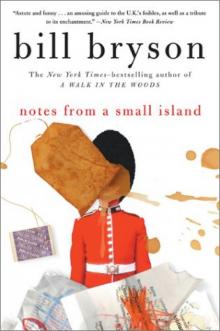 Notes from a Small Island
Notes from a Small Island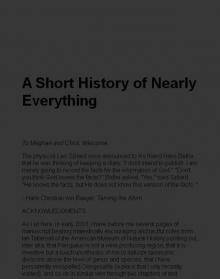 A Short History of Nearly Everything
A Short History of Nearly Everything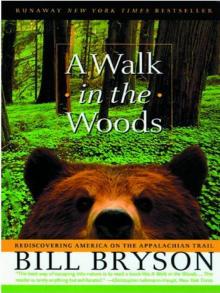 A Walk in the Woods
A Walk in the Woods I'm a Stranger Here Myself
I'm a Stranger Here Myself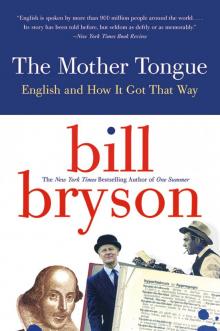 The Mother Tongue
The Mother Tongue Shakespeare
Shakespeare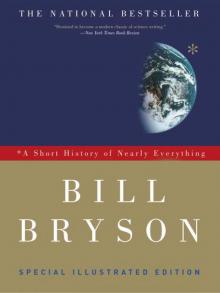 A Short History of Nearly Everything: Special Illustrated Edition
A Short History of Nearly Everything: Special Illustrated Edition The Best American Travel Writing 2016
The Best American Travel Writing 2016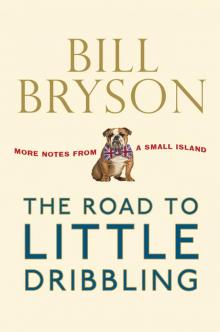 The Road to Little Dribbling
The Road to Little Dribbling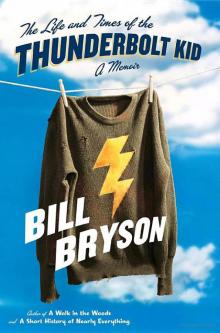 The Life And Times Of The Thunderbolt Kid: A Memoir (v5.0)
The Life And Times Of The Thunderbolt Kid: A Memoir (v5.0)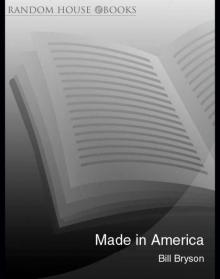 Made In America
Made In America Seeing Further
Seeing Further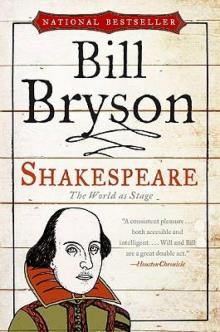 Shakespeare: The World as Stage
Shakespeare: The World as Stage The Life and Times of the Thunderbolt Kid
The Life and Times of the Thunderbolt Kid At Home
At Home Bryson's Dictionary For Writers And Editors (v5.0)
Bryson's Dictionary For Writers And Editors (v5.0) Neither Here Nor There
Neither Here Nor There Bill Bryson's African Diary
Bill Bryson's African Diary